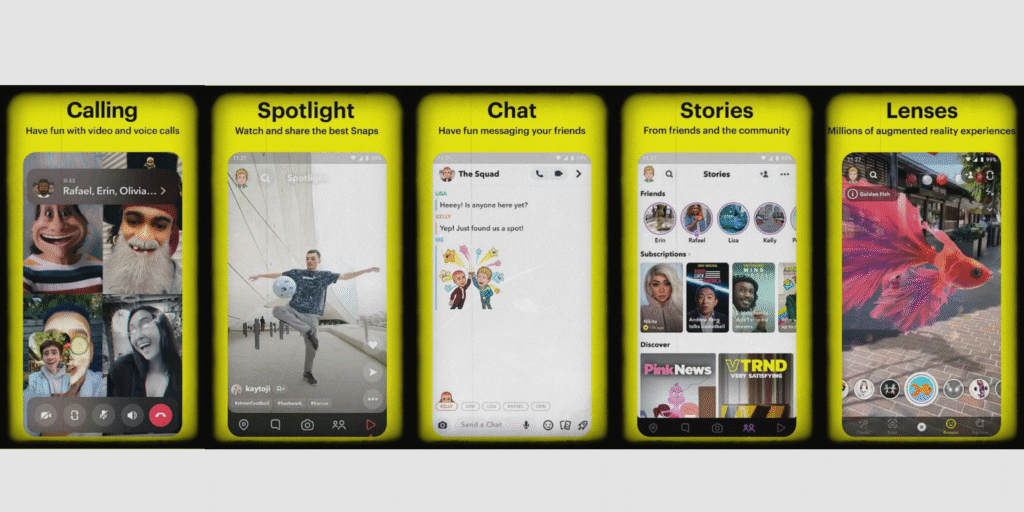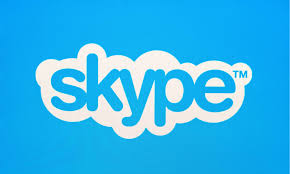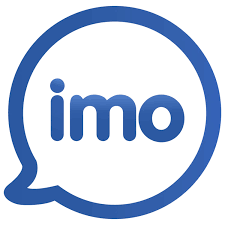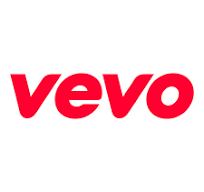- Since its establishment in 2011 under Snap Inc., how has Snapchat evolved as a multimedia messaging platform?
- With a user base of 750 million individuals, what sets Snapchat apart as a favored platform for content sharing?
- How does Snapchat maintain daily engagement from 332 million users, showcasing its ongoing relevance?
- How has Snapchat evolved since its founding in 2011, moving beyond its initial purpose?
- What unique approach to social media did Snapchat introduce, and how does it differentiate itself?
- How has Snapchat expanded its features beyond ephemeral messaging since its inception?
- What are some key features of Snapchat today, aside from its original disappearing messages?
- What is the significance of Snapchat’s daily active user base, especially considering its growth to 293 million users?
- How does Snapchat utilize partnerships and campaigns to enhance its monetization efforts?
- What notable controversies has Snapchat faced, and how has it addressed them?

Introduction to Snapchat:
Since its inception in 2011, Snapchat has risen as a vibrant and widely embraced multimedia messaging platform.
Top of Form
Snapchat, the brainchild of Evan Spiegel, Bobby Murphy, and Reggie Brown – all of whom met during their time at Stanford University, has emerged as a pioneering platform in the realm of social media. Focused on catering to a mobile-first audience, Snapchat has become synonymous with interactive digital elements like virtual stickers and augmented reality features, pushing the boundaries of traditional messaging apps.

Core Features:
At its heart, Snapchat revolutionized the way we think about digital communication with its ephemeral messaging system. Photos and texts sent through the app are designed to disappear after a short duration, a feature that initially defined the Snapchat experience. However, the app’s functionality has significantly expanded over the years. Today, it includes “Stories” that allow users to compile snaps into a narrative over 24 hours, and “Discover,” a section dedicated to content from various brands presented in short, engaging formats. Furthermore, Snapchat offers a secure space titled “My Eyes Only,” safeguarding personal photos behind password protection. Amidst its growth, Snapchat has also begun to dabble in end-to-end encryption, signaling a future with enhanced privacy and security measures.
User Engagement and Demographic Reach
As of July 2021, Snapchat boasted an impressive daily active user base of 293 million, marking a 23% increase from the previous year. This surge in popularity is reflected in the staggering average of over four billion Snaps exchanged daily. A significant portion of Snapchat’s appeal lies in its popularity among younger audiences, especially those under 16, sparking a dialogue on privacy and the responsibilities of social media platforms in safeguarding young users.
Snapchat’s Ongoing Evolution
Snapchat’s journey from a simple photo-sharing app to a multifaceted platform for interactive and disappearing content showcases its role as a leader in the mobile-first social media movement. With continuous updates and a focus on user engagement through innovative features, Snapchat remains at the forefront of the digital communication sphere, addressing the evolving needs and concerns of its youthful demographic.
sual communication and storytelling.
History
Snapchat’s Evolution: A Journey from Ephemeral Messaging to Multifunctional Platform
Since its inception in September 2011 by Evan Spiegel and Bobby Murphy, Snapchat has experienced a remarkable evolution, transcending its original purpose of ephemeral photo messaging.
Expanding Functionality: Beyond Ephemeral Messaging
Snapchat’s initial focus on disappearing photos has expanded into a diverse array of features. Users can now engage in activities ranging from sending pictures and sharing stories to chatting, watching news, making video calls, playing games, and embellishing content with creative elements like emojis and drawings.
Design Adaptations: Reflecting User Preferences
Snapchat’s design has continuously evolved to accommodate new functionalities and enhance user experience. From the introduction of symbols such as cubes for incoming snaps to the integration of stories, chats, Bitmojis, and best friend emojis, each design update aims to make the app more visually appealing and user-friendly.
Mission and Vision: Catalysts for Innovation and Impact
Snap, Inc., Snapchat’s parent company, has articulated a mission statement emphasizing innovation and societal betterment through technology. Aligned with this vision, Snapchat strives to reinvent smartphone camera usage and foster positive interactions among users, driving its continuous evolution and technological advancements.
Navigating Controversies and Legal Challenges
Despite its innovative features, Snapchat has encountered controversies, particularly surrounding its initial association with explicit content sharing. Legal battles, such as the dispute with former associate Reggie Brown over ownership of the app’s concept, have required the company to navigate perception and legal obligations, ultimately acknowledging contributions and settling disputes.
Assessing Snapchat’s Value: Weighing Benefits and Concerns
In its current form, Snapchat offers a distinct social media experience, enabling dynamic engagement and creative expression among users. While valued by many for its ability to enhance communication through visual elements, concerns persist regarding potential misuse, especially among younger demographics, highlighting the ongoing need for responsible use and platform oversight.
Snapchat's Evolution:
A Timeline of Growth and Innovation
Snapchat’s journey from a simple photo-sharing app to a multifaceted social media platform is marked by significant milestones, innovations, and expansions. Here’s a comprehensive look at its evolution, highlighting key developments and achievements.
Initial Launch and User Engagement
- September 2011: Snapchat is founded by Evan Spiegel and Bobby Murphy, focusing on ephemeral photo messaging.
- May 2012: The platform sees 25 Snapchat images sent per second.
- November 2012: Users had shared over one billion photos on the iOS app, with daily shares hitting 20 million.
Technical Milestones and Expansion
- October 2012: Snapchat becomes available on Android, broadening its user base.
- June 2013: Introduction of “Banquo”, Snapchat version 5.0 for iOS, featuring speed and design improvements.
- June 2013: Snapchat introduces Snapkidz, a feature for users under 13.
Surging Popularity and Financial Growth
- May 2015: Daily video views reach 2 billion, skyrocketing to 6 billion by November.
- 2016: Snapchat hits 10 billion daily video views.
- May 2016: The company raises $1.81 billion in equity offering.
- May 31, 2016: Snapchat boasts almost 10 million daily active users in the United Kingdom.
Legal Challenges and Product Launch
- 2016: Investel Capital Corp sues Snapchat over geofiltering patent infringement.
- September 2016: Snapchat Inc. rebrands to Snap Inc., introducing Spectacles.
- February 20, 2017: Spectacles become available for online purchase.
User Interface Redesign and Market Impact
- November 2017: Snapchat announces a controversial redesign.
- February 2018: A critical tweet from Kylie Jenner causes a significant market value drop for Snap Inc.
Recognition and Acquisitions
- December 2019: Snapchat is named the 5th most downloaded mobile app of the decade by App Annie.
- January 2020: Acquisition of AI Factory to enhance video capabilities.
Monetization and User Growth Strategies
- November 2020: Introduction of Snapchat Spotlight, paying users for viral videos.
- June 2022: Announcement of Snapchat Plus, a paid subscription model.
- July 2022: Snapchat reports 347 million daily active users, an 18% increase year-over-year.
- August 2022: Snapchat Plus surpasses 1 million subscribers, adding new features to the service.
This timeline encapsulates Snapchat’s dynamic growth, reflecting its adaptability, resilience, and continuous quest for innovation in the digital and social media landscape.
Business:
Demographics
Snapchat’s Target Audience
Since its inception, Snapchat has attracted primarily Generation Z users, as indicated by its age classification on app stores (12+). Research conducted by the University of Washington and Seattle Pacific University revealed that while Snapchat was initially thought to be used for privacy-sensitive content like sexting, it’s predominantly used for creative and comedic purposes.
- Primary Usage Patterns
- Only 1.6% of users reported using Snapchat primarily for sexting.
- 2% admitted to sending sexual content at some point.
- 8% reported using Snapchat for comedic content like “stupid faces”.
- Content Restrictions
- Majority of users (74.8% – 93.7%) were not willing to send sensitive, legally questionable, or mean content.
- User Behavior
- Most users (79.4%) were aware that snaps could be recovered.
- Adjustments in snap timeout were based on factors like trust, relationship, and content type.
Communication:
Snapchat’s Unique Approach
Snapchat introduced a novel approach to social media, emphasizing real-time sharing over accumulating permanent status. With a mobile-first focus, it differentiated itself from other platforms by placing importance on ephemeral interactions.
- Mobile-Centric
- Launched as a mobile-first company, leveraging the rise of cellular communication.
- Evan Spiegel dubbed Snapchat as primarily a camera company, distinguishing it from traditional social media platforms.
- Content Presentation
- Introduced Discover channel for media and news content.
- Maintained a clear distinction between brand content and user-generated content.
Monetization:
Revenue Generation Strategy
Snapchat strategically implemented features to monetize its platform, starting with advertising efforts and later expanding into sponsored content and partnerships.
- Advertising Initiatives
- Introduced paid advertising with a 20-second movie trailer in 2014.
- Launched “Discover” feature for short-form content from publishers.
- Offered sponsored geofilters and ad placements within Live Stories.
Campaigns:
Partnerships and Marketing Campaigns
Snapchat forged partnerships with various entities to host live stories, create branded lenses, and feature exclusive content.
- Partnerships
- Teamed up with the NFL to present live stories from games.
- Collaborated with Gatorade for animated Super Bowl filters.
- Partnered with NBC Olympics for coverage during the 2016 Summer Olympics.
Development Platform:
Snap Kit and Third-Party Integration
Snapchat introduced Snap Kit, enabling third-party developers to integrate with the platform, promoting privacy-conscious features.
- Snap Kit Components
- “Login Kit” for social login with limited data access.
- “Creative Kit” for generating stickers.
- “Story Kit” for aggregating publicly posted stories.
Snap Originals:
Original Programming and Shoppable Content
Snapchat ventured into original programming with Snap Originals, including scripted shows and documentaries, and introduced shoppable content.
- Shoppable Originals
- Launched “The Drop,” a shoppable show featuring celebrity collaborations in streetwear.
- All original programming ceased by August 2022.
Premium Accounts:
Innovation in Monetization
In 2014, Snapchat rolled out Snapcash, a groundbreaking feature that significantly boosted its appeal, particularly among creators in the adult content sphere.
Monetizing User Content
Snapchat offers the option for private premium accounts, enabling users to monetize their content directly on the platform.
- User Engagement
- These premium accounts are predominantly utilized by models and creators to monetize adult content.
Integration with Adult Industry:
Emerging Role in Online Porn
Snapchat’s facilitation of private premium accounts has led to its increasing involvement in the online porn industry, with adult content creators leveraging the platform for monetization and audience engagement.
Controversies:
December 2013 Hack
Security Breach
In December 2013, Snapchat experienced a significant security breach where hackers gained access to millions of user accounts, prompting widespread concern.
- Vulnerability Disclosure
- Australian security firm, Gibson Security, disclosed an API vulnerability to Snapchat in August 2013.
- The exploit’s source code was made public on December 25, leading to the hack.
- Data Compromise
- Hackers exposed approximately 4.6 million Snapchat usernames and phone numbers.
- Snapchat responded by implementing mitigating features, but hackers bypassed them.
Federal Trade Commission Settlement:
Privacy Concerns
In 2014, Snapchat settled a complaint filed by the US Federal Trade Commission (FTC), addressing allegations of misleading claims regarding user data privacy.
- FTC Allegations
- The FTC accused Snapchat of exaggerating the ability to make photos disappear.
- Snapchat agreed to be monitored by an independent party for 20 years regarding privacy claims.
- Policy Updates
- Snapchat revised its privacy page, clarifying that messages may not be deleted immediately.
- Despite deletion from servers, data might still persist in backups.
Windows App Crackdown:
Third-Party App Removal
In November 2014, Snapchat initiated a crackdown on third-party apps, affecting users on the Windows Phone platform due to the absence of an official Snapchat client.
- Removal of Third-Party Apps
- Third-party apps like 6snap were removed from the Windows Phone Store.
- Despite user requests, Snapchat didn’t develop an official app for the platform.
Lens Incidents:
Safety Concerns
Snapchat faced criticism due to incidents involving its “Lens” feature, which allowed users to record speed while driving, leading to accidents.
- Legal Consequences
- Lawsuits were filed against Snapchat by victims and their families following accidents.
- Snapchat was accused of negligence for allowing its app to be used in dangerous situations.
“Poor Country” Remark:
Allegations of Discrimination
Former employee Anthony Pompliano alleged that Snapchat’s CEO made derogatory remarks about certain countries, leading to public backlash and calls to boycott the app.
- Public Outcry
- The remark sparked outrage on social media, prompting the trending hashtag “#UninstallSnapchat.”
- Snapchat faced criticism and a decline in its stock value.
Pompliano Lawsuit:
Deception Allegations
In a lawsuit filed in 2017, Pompliano accused Snapchat of manipulating growth metrics to deceive investors, resulting in significant legal and financial repercussions for the company.
- Legal Battle
- Pompliano’s claims against Snapchat led to multiple class-action lawsuits and Federal investigations.
- Snapchat faced scrutiny over its handling of the lawsuit’s disclosure.
“Snap Map” Privacy Concerns:
Location Tracking Controversy
The introduction of the “Snap Map” feature raised concerns about privacy and safety due to its potential for exposing users’ locations.
- Safety Warnings
- Police issued warnings about potential risks, especially for teenagers.
- Users were encouraged to operate in “Ghost Mode” to protect their privacy.
Rihanna Controversy:
Insensitive Advertisement
Snapchat faced criticism and calls for boycotts after hosting an insensitive advertisement regarding domestic violence involving Rihanna and Chris Brown.
- Public Backlash
- Rihanna condemned the advertisement, labeling it as insensitive to domestic violence victims.
- The incident led to a public outcry against Snapchat.
Body Image Concerns:
Influence of Editing Tools
The use of body and facial reshaping applications like Snapchat and Facetune raised concerns about their impact on body image and mental health.
- Snapchat Dysmorphia
- Researchers identified a phenomenon termed “Snapchat dysmorphia,” where individuals seek surgery to resemble filtered versions of themselves.
Snapchat Employee Data Abuse:
Unauthorized Access
Reports surfaced in 2019 revealing that Snapchat employees abused internal tools to spy on users, raising serious privacy concerns.
- Internal Data Breach
- Snapchat employees misused an internal tool called SnapLion to access user data without authorization.
- The incident highlighted vulnerabilities in Snapchat’s data security protocols.
Illinois Biometric Data Lawsuit:
Violation of Privacy Laws
Snapchat faced a class-action lawsuit in Illinois for allegedly violating biometric privacy laws by collecting and storing user data without proper consent.
- Legal Settlement
- Snapchat settled the lawsuit with a $35 million payout, acknowledging violations of biometric privacy laws.
- The case underscored the importance of transparent data practices in tech companies.
Conclusion:
In Conclusion, Snapchat has transformed from a simple ephemeral messaging app into a multifaceted platform that transcends traditional social media boundaries. Its journey, marked by innovation, resilience, and adaptability, reflects its commitment to meeting the evolving needs of its user base. From pioneering features like disappearing messages to embracing augmented reality and original content, Snapchat has continually pushed the envelope, solidifying its position as a leader in the digital communication sphere.
As Snapchat continues to evolve, it grapples with challenges ranging from privacy concerns to controversies surrounding its features and business practices. However, these obstacles have spurred introspection and prompted the company to reassess its policies and practices continually. With a user-centric approach and a focus on fostering positive interactions, Snapchat navigates these challenges while striving to uphold its mission of innovation and societal betterment through technology.
In conclusion, Snapchat’s journey exemplifies the dynamic nature of the digital landscape, where innovation, adaptation, and responsible practices are paramount. As it forges ahead, Snapchat remains dedicated to redefining the way we communicate and engage with each other, shaping the future of social media in the process.
FAQs:
Introduction to Snapchat:
- How long has Snapchat been in operation?
- Since its inception in 2011, Snapchat has been operating under Snap Inc.
- What distinguishes Snapchat from other messaging platforms?
- Snapchat is known for its dynamic and popular multimedia messaging platform, offering innovative ways for users to share content.
- How large is Snapchat’s user base?
- Snapchat boasts a considerable user base of 750 million individuals.
A Dynamic Messaging Experience:
- Who are the founders of Snapchat?
- Snapchat was founded by Evan Spiegel, Bobby Murphy, and Reggie Brown, who met during their time at Stanford University.
- What distinguishes Snapchat in terms of features?
- Snapchat is renowned for its interactive digital elements like virtual stickers and augmented reality features, catering to a mobile-first audience.
Core Features:
- What is the primary feature that initially defined Snapchat’s experience?
- Snapchat revolutionized digital communication with its ephemeral messaging system, where photos and texts disappear after a short duration.
- How has Snapchat’s functionality evolved over time?
- Snapchat now includes features like “Stories” for compiling snaps into narratives and “Discover” for engaging content from various brands.
User Engagement and Demographic Reach:
- How many daily active users does Snapchat have?
- As of July 2021, Snapchat boasts an impressive daily active user base of 293 million.
- What demographic is particularly drawn to Snapchat?
- Snapchat is popular among younger audiences, especially those under 16, contributing to its significant engagement.
Snapchat’s Ongoing Evolution:
- How has Snapchat evolved since its inception?
- Snapchat has transitioned from a simple photo-sharing app to a multifaceted platform for interactive and disappearing content.
- What keeps Snapchat at the forefront of digital communication?
- Snapchat remains innovative with continuous updates and a focus on user engagement through features that address evolving needs and concerns.
Snapchat’s Growth:
- What milestones mark Snapchat’s growth and innovation?
- Snapchat’s growth is marked by significant milestones, expansions, and innovations since its inception in 2011.
- How has Snapchat’s user base expanded over the years?
- Snapchat’s user base has surged, with milestones such as reaching 10 million daily active users in the United Kingdom by May 2016.
Business:
Demographics:
- Who primarily uses Snapchat?
- Snapchat primarily attracts Generation Z users, with usage patterns leaning towards creative and comedic content.
- What content restrictions does Snapchat impose?
- Snapchat users are reluctant to send sensitive or mean content, with the majority avoiding such material.
Communication:
- How does Snapchat differentiate itself in social media?
- Snapchat emphasizes real-time sharing and ephemeral interactions, distinguishing itself with a mobile-first approach.
Monetization:
- What strategies has Snapchat employed for revenue generation?
- Snapchat has implemented advertising initiatives, partnerships, and features like Snapcash and premium accounts for monetization.
Controversies:
- What controversies has Snapchat faced?
- Snapchat has encountered controversies ranging from security breaches to allegations of deception and privacy concerns, prompting public outcry and legal actions.

Prof. Mian Waqar Ahmad
Prof. Mian Waqar Ahmad, a dynamic force straddling the realms of academia and digital media. As a distinguished Lecturer in Information Sciences, he imparts knowledge within the academic sphere, igniting the minds of his students. Beyond the classroom, Prof. Mian Waqar Ahmad dons the hat of a seasoned blogger on Worldstan.com, where his insightful posts delve into the intricacies of information sciences. His digital footprint extends even further as a YouTuber, leveraging the platform to share his expertise and make complex concepts accessible to a global audience. Prof. Mian Waqar Ahmad’s journey embodies the fusion of traditional education and contemporary digital outreach, leaving an indelible mark on the evolving landscape of information sciences. Explore his world at Worldstan.com and witness the convergence of academia and the digital frontier.


































